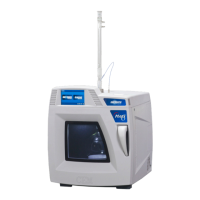
Do you have a question about the CEM MARS 6 Synthesis and is the answer not in the manual?
| Brand | CEM |
|---|---|
| Model | MARS 6 Synthesis |
| Category | Synthesizer |
| Language | English |
Explains the use of three safety alert words (NOTE, CAUTION, WARNING) for potential hazards.
Describes the MARS 6 Synthesis as a multi-mode microwave system with parallel reaction processing.
Lists representative examples of microwave absorptive properties for common synthetic solvents.
Details the minimum cavity load required based on solvent, number of vessels, and vessel type.
Lists safety precautions for operating the microwave system and vessels.
Identifies and describes the front and side components of the instrument with numbered labels.
Identifies and describes the back and side components of the instrument with numbered labels.
Details the components within the microwave cavity, including seals, covers, and sensors.
Provides a visual guide to the icons used in the software interface and their meanings.
Describes the initial screen displayed upon system startup and its accessible areas.
Provides a basic review of each section within the System Menu for locating software items.
Details the various settings available for system configuration, user management, and run adjustments.
Displays the logout screen and the confirmation prompt for exiting the system.
Provides step-by-step instructions for unboxing the MARS 6 Synthesis instrument.
Details the steps for connecting the exhaust hose, power cord, and ensuring proper installation.
Guides users through the process of creating a new classic method for synthetic chemistry applications.
Explains how to edit existing methods and the consequences of saving changes.
Outlines the procedure for deleting methods from the system.
Describes how to export methods to a USB drive for backup or transfer.
Details the process of importing methods from a USB drive into the system.
Guides administrators on creating new user accounts with different access levels.
Explains how administrators can edit or delete existing user accounts.
Describes how to configure the auto login feature for user access.
Explains how to view, print, and export data associated with a specific method run.
Describes the activity log, how to filter it, and how to export or print entries.
States that calibration is not required for the fiber optic probe, but GF number entry is needed.
States that calibration is not required for pressure control.
Details the process of verifying temperature using the optional AutoCal device.
Explains the procedure for calibrating IR sensors using the AutoCal device.
States that pressure calibration must be performed by a CEM Certified Service Representative.
Describes the functionality of the optional internal thermal printer for method data.
Guides on installing the fiber optic probe and entering the GF number.
Explains how to verify the installed fiber optic probe's temperature reading.
Provides instructions on proper care and handling of the fiber optic temperature probe.
Lists common problems, their possible causes, and suggested solutions for the instrument.
Outlines the necessary environmental and spatial requirements for installing the instrument.
Details the electrical specifications, voltage, and plug types required for operation.
Lists the environmental conditions (temperature, humidity, altitude) for instrument operation.
Provides details about what is covered, for how long, and what is not covered by the warranty.
States the warranty disclaimer, excluding implied warranties and limiting liability.
Identifies and describes the individual parts of the GlassChem 20 vessels.
Lists the operating parameters, power settings, and ideal chemistry for GlassChem 20 vessels.
Details the break-in procedure to condition new vessel caps and vent plugs for proper sealing.
Provides step-by-step instructions for assembling vessels and performing a reaction.
Guides on how to properly place vessel assemblies onto the turntable for optimal distribution.
Explains how to load a method and perform a reaction using the GlassChem 20 vessels.
Provides instructions for safely removing vessels from the instrument after a reaction.
Outlines the procedure for cleaning GlassChem 20 vessels and vent plugs.
Identifies and illustrates the components of EasyPrep and EasyPrep Plus vessels.
Lists operating parameters, power settings, and ideal chemistry for EasyPrep vessels.
Details the break-in procedure for conditioning new EasyPrep liners and covers.
Provides general instructions for performing reactions with EasyPrep vessels.
Guides on loading the control vessel and ensuring proper engagement with the turntable.
Explains how to load a method and perform a reaction using EasyPrep vessels.
Provides instructions for safely removing EasyPrep vessels after a reaction.
Outlines the procedure for cleaning EasyPrep liners and covers.
Identifies and describes the components of open vessels used in reactions.
Lists operating parameters, power settings, and ideal chemistry for open vessels.
Guides on preparing round bottom flasks for reactions, including inspection and reagent addition.
Explains how to load a method and perform a reaction using open vessels.
Provides instructions for safely removing flasks after an open vessel reaction.
Provides contact information and resources for technical support and service.